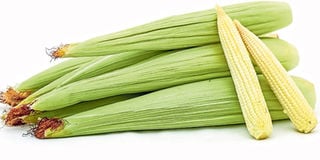All about farming nutritious baby corn for higher yields

Baby corn. The product is a dietary source of potassium, vitamin B6, riboflavin, vitamin C and fibre. FILE PHOTO | NMG
What you need to know:
- The corn can be consumed cooked or raw due to its sweet and succulent taste.
- Ear quality and more yield should be the primary objectives when selecting a variety.
- For baby corn as a primary crop, all ears are harvested.
- Baby corn can be sold either by the ear numbers or by weight.
Baby corn (Zea mays L.) is dehusked maize ear, harvested young especially when the silk has either not emerged or has just emerged.
Baby corn ears in light-yellow colour with regular row arrangement, 10 to 12cm long and a diameter of 1.0 to 1.5cm arrangement are the best for the market.
Baby corn can be a profitable crop that allows a diversification of production and aggregation of value.
The corn can be consumed cooked or raw due to its sweet and succulent taste. Many people presume the tiny ears come from dwarf corn plants.
However, they come from the immature ear of fully-grown standard cultivars. The ears are harvested two or three days after emergence of silk, but before fertilisation.
Production
There is no taste advantage in growing a sweetcorn variety over field corn, because the ears are harvested before the sugars accumulate. However, sweetcorn cultivars tend to be easier to hand-harvest.
Ear quality and more yield should be the primary objectives when selecting a variety. Small kernel size, straight row alignment, and tapered tips are preferred characteristics for high quality baby corn.
The cultivars are shorter than traditional types, produce multiple stalks, and can yield as many as 20 ears per plant.
Initial investments include land preparation and purchase of seeds. Farmers choosing to use a sweetcorn variety may incur higher seed costs than those using field corn for baby corn production.
Field corn varieties producing multiple ears can result in higher yields, especially if the ears are of high quality. Costs and returns will be affected by the production method used, with differences seen if baby corn is a primary or secondary crop.
For baby corn as a primary crop, all ears are harvested. For baby corn as a secondary crop, the second ear from the top of the plant is harvested to allow the top ear to mature for sweetcorn or field corn.
This method allows the farmer to use the secondary ear that otherwise may not mature for sweetcorn production or, in the case of field corn, would not contribute greatly to silage yield.
Most cultivars should produce marketable ears in three to four weeks, though very early cultivars may have a shorter harvest period of two weeks.
Baby corn can be sold either by the ear numbers or by weight. Ears with the husks intact can be refrigerated for up to one week without losing quality.
How to use the corn
When ready to use baby corn, remove the husk and silks, and wash the ears; be very gentle as they are tender and can easily snap.
Whether it is eaten raw or cooked, the entire tiny ear of the corn is edible.
If using in a cooked recipe, steam baby corn ears for five minutes, or until tender, before adding to other dishes.
Baby corn is high in folate, providing 31 per cent of the recommended daily amount. It is also a dietary source of potassium, vitamin B6, riboflavin, vitamin C and fibre.
The writer is based at the Department of Human Nutrition, Egerton University.




